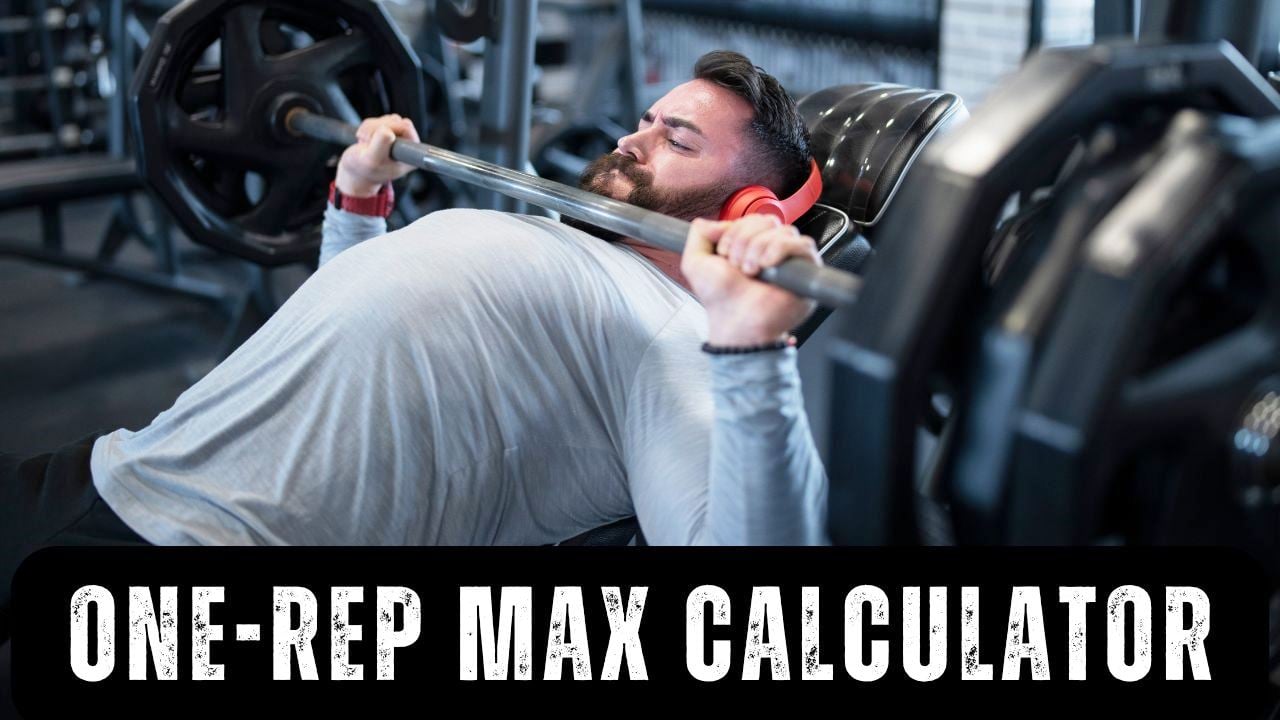🏋️ One Rep Max Calculator
Calculate your One Rep Max (1RM) using scientifically validated formulas. Get personalized training recommendations and percentage-based workout plans to maximize your strength gains safely and effectively.

Understanding One Rep Max (1RM) Training
Scientific Foundation
One Rep Max (1RM) represents the maximum weight an individual can lift for a single repetition with proper form. Research published in Sports Medicine demonstrates that 1RM testing is a reliable and valid method for assessing muscular strength across various populations. The 1RM serves as the gold standard for strength assessment and is fundamental for designing effective resistance training programs.
Training Applications
Systematic reviews in strength training show that percentage-based training using 1RM values optimizes strength development. Training at 85-95% of 1RM maximizes neural adaptations for strength, while 65-80% promotes muscle hypertrophy. Understanding your 1RM allows for precise load prescription and progressive overload implementation.
Calculation Methods
Validation studies confirm that indirect 1RM estimation using submaximal loads provides accurate predictions. The Brzycki, Epley, and Lander formulas show high correlation (r > 0.95) with actual 1RM values, making them safe and practical alternatives to direct maximal testing.
Safety Considerations
Sports injury research emphasizes that proper 1RM testing protocols significantly reduce injury risk. Adequate warm-up, progressive loading, proper form, and qualified supervision are essential. Indirect estimation methods eliminate many risks while providing reliable data for training prescription.
Periodization Integration
Contemporary periodization research demonstrates that 1RM-based programming enhances training outcomes. Systematic manipulation of training loads relative to 1RM optimizes strength, power, and hypertrophy adaptations. Regular 1RM assessment allows for program adjustments and ensures continued progress throughout training cycles.
Common 1RM Calculation Formulas
Brzycki Formula (1993)
Formula: 1RM = Weight × (36 ÷ (37 – Reps))
Validation research
shows this formula is highly accurate for repetitions under 10, particularly for upper body exercises. It demonstrates
correlation coefficients of r = 0.98 for bench press movements and is widely used in strength training programs.
Epley Formula (1985)
Formula: 1RM = Weight × (1 + 0.0333 × Reps)
Comparative studies
demonstrate that the Epley formula works well across multiple repetition ranges and is particularly effective for
compound movements. It’s considered one of the most versatile formulas for different population groups.
Lander Formula (1985)
Formula: 1RM = (100 × Weight) ÷ (101.3 – 2.67123 × Reps)
Research from Southern Illinois University
indicates this formula provides conservative estimates and is particularly useful for novice lifters and moderate rep ranges (5-10 reps).
Lombardi Formula (1989)
Formula: 1RM = Weight × (Reps^0.10)
This formula uses exponential calculations and is particularly effective for lower repetition ranges (1-5 reps).
It’s commonly used in powerlifting and strength sports where precision at high intensities is crucial.
Formula Comparison Analysis
| Formula | Best Rep Range | Accuracy | Exercise Type | Population |
|---|---|---|---|---|
| Brzycki | 2-10 reps | Very High (r=0.98) | Upper body | Trained athletes |
| Epley | 1-10 reps | High (r=0.95) | All movements | General population |
| Lander | 5-10 reps | Moderate (r=0.92) | Compound lifts | Beginners |
| Lombardi | 1-5 reps | High (r=0.94) | Power movements | Advanced lifters |
| Average Method | 1-15 reps | Very High (r=0.97) | All exercises | All levels |
Formula Selection Guidelines
For Beginners: Use Lander or Average method for conservative estimates
For Intermediate: Epley formula works well across all exercises
For Advanced: Brzycki for upper body, Lombardi for low reps
For Research: Average of multiple formulas provides highest accuracy
Standard 1RM Strength Benchmarks
Male Strength Standards (kg)
| Exercise | Beginner | Novice | Intermediate | Advanced | Elite |
|---|---|---|---|---|---|
| Bench Press | 40-60kg | 60-80kg | 80-100kg | 100-140kg | 140kg+ |
| Squat | 50-80kg | 80-100kg | 100-140kg | 140-180kg | 180kg+ |
| Deadlift | 60-100kg | 100-130kg | 130-170kg | 170-220kg | 220kg+ |
| Overhead Press | 25-40kg | 40-55kg | 55-70kg | 70-90kg | 90kg+ |
Female Strength Standards (kg)
| Exercise | Beginner | Novice | Intermediate | Advanced | Elite |
|---|---|---|---|---|---|
| Bench Press | 20-35kg | 35-50kg | 50-65kg | 65-85kg | 85kg+ |
| Squat | 30-50kg | 50-70kg | 70-95kg | 95-125kg | 125kg+ |
| Deadlift | 40-60kg | 60-85kg | 85-115kg | 115-150kg | 150kg+ |
| Overhead Press | 15-25kg | 25-35kg | 35-45kg | 45-60kg | 60kg+ |
Benchmark Interpretation
These standards are based on normative strength data from recreational to competitive lifters. Standards assume proper training experience and technique. Individual variations exist based on body weight, training history, genetics, and age. Use these as general guidelines rather than absolute targets.
Scientific Periodization Model
| Training Phase | Duration | Intensity (%1RM) | Volume (Reps) | Sets | Rest Period | Primary Goal |
|---|---|---|---|---|---|---|
| Anatomical Adaptation | 4-6 weeks | 50-70% | 12-20 | 2-3 | 30-60s | Movement patterns, conditioning |
| Hypertrophy | 4-6 weeks | 65-80% | 6-12 | 3-4 | 60-90s | Muscle mass development |
| Maximum Strength | 4-6 weeks | 80-95% | 1-6 | 3-6 | 3-5 min | Neural adaptation, max force |
| Power/Peak | 2-4 weeks | 85-100% | 1-3 | 3-5 | 3-5 min | Competition preparation |
| Active Recovery | 1-2 weeks | 40-60% | 8-15 | 2-3 | 60-90s | Recovery, technique refinement |
Periodization Principles
Contemporary periodization research demonstrates that systematic variation of training variables optimizes strength development. Progressive overload through intensity manipulation, volume cycling, and strategic recovery periods prevents plateaus and reduces injury risk. Regular 1RM testing allows for program adjustments and ensures appropriate load prescription throughout each phase.
Advanced Training Techniques
Cluster Sets
Protocol: 3-5 reps with 15-30 seconds rest between reps
Intensity: 85-95% 1RM
Benefits: Maintains power output, allows higher volume at max intensities
Research shows cluster sets
enhance strength development by maintaining force production throughout the set.
Wave Loading
Protocol: Progressive load increases within and between sets
Example: 85% × 3, 90% × 2, 95% × 1, repeat
Benefits: Neural potentiation, strength-speed development
This method capitalizes on post-activation potentiation to enhance performance.
Accommodating Resistance
Methods: Chains, bands, variable resistance machines
Application: 60-80% base weight + 20-25% accommodating resistance
Benefits: Matches strength curve, develops explosive strength
Particularly effective for powerlifting and athletic performance enhancement.
Frequently Asked Questions
How often should I test my 1RM?
Beginners: Every 8-12 weeks to allow sufficient adaptation
Intermediate: Every 6-8 weeks during strength phases
Advanced: Every 4-6 weeks or before competitions
Avoid testing during high-fatigue periods or deload weeks. Use indirect methods more frequently for monitoring progress.
What’s the proper warm-up protocol for 1RM testing?
Step 1: 5-10 minutes general warm-up (light cardio)
Step 2: Dynamic stretching and movement preparation
Step 3: 50% 1RM × 5-8 reps
Step 4: 70% 1RM × 3-5 reps
Step 5: 80% 1RM × 2-3 reps
Step 6: 90% 1RM × 1 rep
Step 7: Attempt 1RM
Rest 3-5 minutes between warm-up sets.
How do I break through strength plateaus?
Deload Week: Reduce volume/intensity by 40-50%
Exercise Variation: Change grip, stance, or range of motion
Accessory Work: Target weak points in the movement
Technique Review: Video analysis and coaching feedback
Recovery Assessment: Evaluate sleep, nutrition, and stress
Should I prioritize form or weight when training?
Always prioritize proper form. Poor technique increases injury risk and reduces training effectiveness. Record your lifts for form analysis, work with qualified coaches, and increase weight only when form remains consistent. Master proper lifting techniques before pursuing maximum loads.
How accurate are 1RM prediction formulas?
Most validated formulas show correlation coefficients of r = 0.95-0.98 with actual 1RM values. Accuracy is highest with 2-10 repetitions and decreases with higher rep ranges. Individual factors like training experience, muscle fiber type composition, and exercise technique can affect accuracy. Use multiple formulas and compare results for best estimates.
What are signs of proper recovery between sessions?
Physical Signs: Normal resting heart rate, absence of lingering soreness
Performance Signs: Maintained or improved strength, good movement quality
Psychological Signs: Motivation to train, mental readiness
Sleep Quality: 7-9 hours of restorative sleep
Energy Levels: Consistent throughout the day
Nutrition for Maximum Strength
Pre-Workout Nutrition
Timing: 2-3 hours before training
Carbohydrates: 1-2g per kg body weight for glycogen replenishment
Protein: 20-30g for muscle protein synthesis
Hydration: 500-750ml water 2-3 hours prior
Post-Workout Recovery
Protein: 25-40g within 2 hours post-training
Carbohydrates: 1-1.5g per kg body weight for glycogen restoration
Hydration: Replace 150% of fluid lost during training
Micronutrients: Focus on anti-inflammatory foods
Daily Nutritional Requirements
Protein: 1.6-2.2g per kg body weight for strength athletes
Carbohydrates: 4-7g per kg body weight depending on training volume
Fats: 20-30% of total daily calories
Water: 35-40ml per kg body weight minimum
Equipment and Safety Guidelines
Essential Safety Equipment
Power Rack: With adjustable safety pins set 2-3 inches below lowest point
Spotters: Experienced individuals familiar with the lift
Proper Footwear: Flat, stable shoes with good grip
Lifting Belt: For maximal attempts and heavy training
Wrist Wraps: For pressing movements and joint support
Gym Safety Protocols
Communication: Clear signals with spotters before attempts
Environment: Clear lifting area, proper lighting, non-slip surfaces
Emergency Plan: Know location of first aid and emergency contacts
Progressive Loading: Never jump more than 5-10% between attempts
Failure Protocol: Practice safe failure techniques for each lift
References
- Mayhew, Jerry L; Johnson, Blair D; LaMonte, Michael J; Lauber, Dirk; Kemmler, Wolfgang (September 2008). “Accuracy of Prediction Equations for Determining One Repetition Maximum Bench Press in Women Before and After Resistance Training”. Journal of Strength and Conditioning Research. 22 (5): 1570–1577.
- Knutzen, Kathleen; Brilla, Lorraine; Caine, Dennis (August 1999). “Validity of 1RM Prediction Equations for Older Adults”. The Journal of Strength & Conditioning Research. 13 (3): Vol 13, Issue 3, Page 242–246. Retrieved 11 July 2014.
- Epley, Boyd (1985). “Poundage Chart”. Boyd Epley Workout. Lincoln, NE: Body Enterprises. p. 86.
- Brzycki, Matt (1998). A Practical Approach To Strength Training. McGraw-Hill. ISBN 978-1-57028-018-4.
- Kemmler, Wolfgang K.; Lauber, Dirk; Wassermann, Alfred; Mayhew, Jerry L. (2006-11-01). “Predicting maximal strength in trained postmenopausal woman”. Journal of Strength and Conditioning Research. 20 (4): 838–842. doi:10.1519/R-18905.1. ISSN 1064-8011. PMID 17194251. S2CID 12769411.
- Chapman, Paul P.; Whitehead, James R.; Binkert, Ronald H. (November 1998). “The 225–1b Reps-to-Fatigue Test as a Submaximal Estimate of 1-RM Bench Press Performance in College Football Players”. Journal of Strength and Conditioning Research. 12 (4): 258–261.
- LeSuer, Dale A.; McCormick, James H.; Mayhew, Jerry L.; Wasserstein, Ronald L.; Arnold, Michael D. (November 1997). “The Accuracy of Prediction Equations for Estimating 1-RM Performance in the Bench Press, Squat, and Deadlift”. Journal of Strength and Conditioning Research. 11 (4): 211–213.
- Reynolds, JM; Gordon, TJ; Robergs, RA (August 2006). “Prediction of one repetition maximum strength from multiple repetition maximum testing and anthropometry” (PDF). Journal of Strength and Conditioning Research. 20 (3): 584–92.
- Naclerio Ayllón, Fernando; Jiménez Gutiérrez, Alfonso; Alvar, Brent A.; Peterson, Mark D. (2009). “Assessing strength and power in resistance training”. Journal of Human Sport and Exercise. 4 (2): 100–113.

Manish is a NASM-certified fitness and nutrition coach with over 10 years of experience in weight lifting and fat loss fitness coaching. He specializes in gym-based training and has a lot of knowledge about exercise, lifting technique, biomechanics, and more.
Through “Fit Life Regime,” he generously shares the insights he’s gained over a decade in the field. His goal is to equip others with the knowledge to start their own fitness journey.
